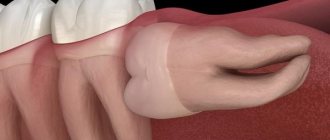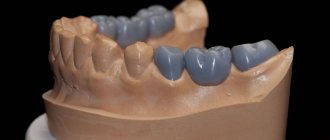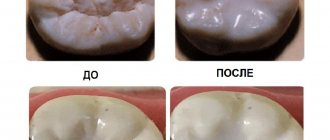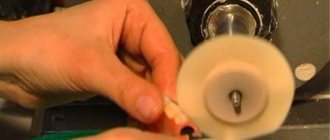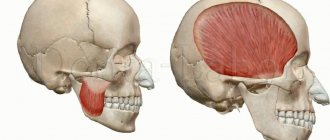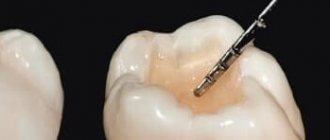53104
Crooked, unhealthy teeth can ruin the appearance of an otherwise attractive person. Oral health is important not only for our attractiveness, because the main function of teeth is to grind food. The condition of the stomach and intestines depends on this, which directly affects health and life expectancy .
How is the bite formed?
The process of bite formation is long - from birth to adolescence. There are 5 periods.
- Initial (up to 6 months): no teeth, the upper jaw is larger in size than the lower jaw. At this time, an active feeding process is extremely important for the proper development of the jaw apparatus.
- Emerging temporary bite (6 months - 3 years): baby teeth and a bite appear, but it is still temporary. This stage is accompanied by inflammation of the gums, a rise in temperature, often grinding of teeth (bruxism), and emerging teeth may be crooked. It is important to maintain hygiene without taking any orthodontic measures.
- Formed temporary occlusion (3 - 6 years): baby teeth have erupted and can close in different ways, jaw growth continues. This is the time of active use of teeth. Characteristic wear of temporary teeth is considered normal before the upcoming change.
- Changeable dentition (6-12 years): jaw growth, loss of baby teeth and appearance of permanent teeth. Often new teeth, especially the lower ones, erupt unevenly. During this period, it is necessary to decide on a plan for further correction of the bite.
- Permanent dentition (12 - 15 years): replacement of milk teeth with permanent ones, all 28 teeth are visible, no wisdom teeth. The period is most favorable for orthodontic treatment.
In order for the bite to form correctly, there must be careful attention to teething, oral hygiene, and a timely plan to correct emerging problems.
What materials are veneers made from?
Only veneers made from a ceramic composition can be considered original.
Sometimes in dentistry, visitors are offered the fixation of veneers made of other materials - on an aluminum or zirconium base. As a budget alternative to such veneers, veneers created from composite can be compared. The production of such veneers in the Russian Federation differs significantly from the technologies usual in Europe. True composite veneers must be produced within the framework of a professional dental laboratory operating in dentistry. Veneers are given a shape identical to the parameters of the patient’s teeth. This is achieved through the preliminary creation of impressions. Impressions for veneers are taken by orthopedic dentists during the process of preparing teeth for attaching veneers.
In Moscow, most clinics do not have their own laboratories, so composite veneers are created in violation of real technology. Such veneers turn into analogues of ordinary filling masses. Veneers are fixed on the surface of the front teeth during treatment procedures using standard restorative compounds with light-curing fillings. This turns the veneer into a typical falsification.
Ceramic veneers
Veneers made from high-quality ceramics have long been awarded the title of Hollywood. Such veneers are often considered analogues of indirect veneers and orthopedic veneers. Such names are dictated by the manufacturing features. The creation of such veneers is not done in dentistry during the session, but in a special laboratory before the start of therapy.
In all the variety of ceramic veneers, two large varieties can be distinguished. In addition to porcelain veneers, Moscow dentists suggest considering the installation of veneers made of zirconium alloys.
Porcelain veneers
Porcelain is rightfully considered the base material for creating veneers. It is most similar to the appearance of human tooth enamel and its structure. The increased strength of the material and the preservation of color throughout the entire service life of the veneers cannot be ignored. Additional translucency improves the aesthetic qualities of veneers.
restoration of front teeth with veneers before and after photos
Quite often, patients are not satisfied with the condition of the restoration of their front teeth. To correct the situation, dental specialists suggest completely eliminating the unsuccessful restoration and fixing veneers made of first-class porcelain to the teeth.
There are two methods that can be used to make porcelain veneers:
The first technique helps achieve maximum aesthetics, and the second is aimed at obtaining maximum strength indicators of the incisors. The method according to which the specialist will act is determined by the dentistry you contacted. The average production time for veneers ranges from one to two weeks. At this time, your ground teeth will be covered with special temporary veneers made of high-quality plastic.
Veneers. Method of layer-by-layer application of porcelain mass and firing it
One of the most common situations considered by employees of any dentistry is the creation of veneers for the fourth and fifth teeth. Dentists prefer to apply a special porcelain mixture to the client’s prepared teeth. It is distributed over the teeth gradually and in layers. During the work process, a dental specialist can vary the thickness, color and level of transparency of the layer to create the highest quality veneers on the visitor’s teeth. This technique allows you to achieve a perfect match of the color of nearby teeth. This is what gives the look a natural look.
Veneers. Injection molding method under pressure and high temperature
Now we are talking about “pressed ceramics”. Veneers produced using this method become less fragile, which contributes to long-lasting wear and increased reliability.
Porcelain veneers for front teeth: before and after photos
Zirconium dioxide ceramic veneers
Zirconium veneers have two layers. The lower one is made up of a high-strength zirconium frame, and the outer surface of the veneer is represented by a porcelain mass. The frame is created using a unique technology of three-dimensional milling of veneers. Dentistry using this technology must have CNC machines. They do not require human intervention, therefore they guarantee products of impeccable quality and accuracy.
The procedure consists of several successive steps. First, in dentistry, a specialist grinds the patient’s teeth for installation of veneers, after which he makes a reliable impression of each incisor being processed. Based on the impression taken, a virtual three-dimensional model of the future veneer will be built using special dental equipment. The operator transfers the data of the simulated veneer to the machine for turning the workpiece.
Zirconium veneers are stronger and harder than pressed porcelain veneers. An excellent result can be achieved in any dentistry in Moscow if its employees strictly follow the technology of firing the resulting blanks for veneers. Unfortunately, it is not uncommon for clinics to violate accepted technology. The technique is completely new, and not every dentist has managed to master it at the proper level. Deviation from the original technology is fraught with the formation of chips on the ceramics after installing veneers on a patient.
Making veneers photo process
Ceramic veneers: reviews, advantages
In addition to excellent aesthetics, installing ceramic veneers in dentistry can achieve:
- — complete color stability throughout the entire service life of the veneers;
- - incredible reliability (the service life of veneers is limited only by a person receiving dental injuries in extreme situations).
The only drawback of ceramic veneers is their rather high price.
Differences between porcelain veneers and zirconium dioxide veneers: By installing porcelain veneers, dental professionals are able to achieve incredible translucency of the material. Zirconium products have more modest translucency indicators because they have increased density.
For patients with a high level of transparency in their own teeth, it is advisable to choose veneers made from a porcelain mixture. For some clients, the tooth enamel has a more saturated color. Then veneers of these two varieties will be quite appropriate. Porcelain veneers can be given the desired degree of translucency by varying the number of layers.
Sign up for a consultation at our clinic
Correct teeth bite
An ideal orthognathic bite implies the presence of the following features:
- The upper dental arch is slightly inclined forward and has the shape of a semi-ellipse, the lower, in the shape of a parabola, is slightly backward.
- When the jaws close, each upper tooth contacts the opposite tooth below.
- There are no obvious gaps between the teeth.
- The upper teeth overlap the lower teeth by about a third of their height.
Despite the fact that there are the above parameters for a perfect smile, the question “What should be the bite of the teeth?” cannot be answered unambiguously. In addition to the orthognathic bite, modern orthodontics allows for several options for the normal structure of the dentition and the location of the jaws.
Orthognathic
The upper row of teeth overlaps the lower one by 30% of the height, there are no gaps between the teeth or spaces between the rows.
Biprognathic
The dentition is slightly directed towards the vestibule of the mouth.
Progenic
The lower jaw moves forward slightly.
Straight
When the jaws close, the upper teeth come into contact with the lower cutting edges.
Malocclusion of teeth
Look at your reflection in the mirror. If you notice an excessively protruding upper or lower lip, teeth that “overlap” each other, or gaps between the dentition when the jaws are closed, this is a clear reason to consult a specialist. Descriptions of dental anomalies and photographs of teeth with malocclusion pathologies are presented in the table below.
Distal (prognathic)
In a distal bite, the upper jaw is more developed than the lower jaw.
Mesial (medial)
With a mesial bite, the lower jaw is pushed forward.
Cross
In a crossbite, the rows of teeth intersect in the manner of scissors when the jaws close.
Deep
In a deep bite, the upper teeth significantly overlap the lower teeth.
Open
The presence of pronounced gaps between the dentition when the jaws are closed indicates an open bite.
Bite in the absence of teeth
A person without teeth has problems with the functioning of the temporomandibular joints, facial aesthetics deteriorate, and wrinkles appear due to loss of skin tone. To avoid unpleasant consequences, it is necessary to restore the bite using a complete denture made using a special technique.
Bite restoration with complete dentures
- The central ratio of the jaws is determined - the position of the lower jaw in relation to the upper in three planes: vertical, sagittal and transversal. The role of the dentition is played by wax rollers.
- Measurements are taken using a device consisting of an external facebow-ruler and an intraoral plate with a flat frontal part and curved distal parts.
- The plaster model marks the boundaries of the future structure, the line of the middle of the alveolar process, the tubercles of the upper and lower jaw, and the midline.
- Artificial teeth are placed in such a way that when you smile, the part of the prosthesis that imitates the gum is not visible.
Composite veneers
Installing veneers made of composites has certain disadvantages.
You can study reviews from patients who have already visited the dentist for this service. This will help you evaluate whether these veneers are right for you. We have collected information from specialists who work in the best dentistry in the country. They note that in the vast majority of cases, dentists create composite veneers directly during a session directly in the visitor’s mouth. This turns veneers into reinforced restoration fillings. The filling is distributed over the front surface of the tooth, but its cost is an order of magnitude higher than a traditional restoration. This technology has nothing in common with classic veneers and is unable to perform their functions. The production of high-quality composite veneers is carried out outside of dentistry - in the laboratory of a dental technician.
The task of dentists is to grind down the teeth to cover them with veneers and take reliable impressions of them. The impressions must be sent to the dentist. The specialist creates a veneer on a light composite, providing it with the necessary qualities. Such veneers acquire high performance properties, but their characteristics cannot be compared with porcelain and zirconium analogues.
Composite veneers: reviews from dentists
Tooth restoration with a composite veneer. Photos before and after
Considering modern composite veneers, one can note their modest aesthetic qualities. Such a coating is not capable of achieving the performance of ceramic veneers. Most patients encounter a problem when a visit to the dentist ends with the fixation of a veneer that does not match the rest of the teeth. Composite compositions are difficult to adapt to the characteristics of natural teeth.
Color stability of composite veneers
Among the indicators of composite veneers, the level of color stability ranks last. During use, such veneers gradually begin to lose their brightness and color. Varieties of ceramic veneers are not susceptible to this, since this material does not change color shade and translucency throughout the entire period of operation.
Strength of materials
Veneers made of composite material are more fragile than ceramic type veneers. Their reliability is incomparable to that of veneers made from zirconium compounds, which have unsurpassed strength. Due to their high fragility, such veneers are installed with the obligatory overlap of the cutting edge of the tooth. This means that you will no longer bite food with your own tooth, but with the veneer.
Manufacturing technology of composite veneers
Dental professionals face quite a difficult task. They need to create a high-quality veneer in your mouth. Achieving the goal is hampered not only by limited time, but also by high humidity and the presence of only artificial lighting. The desired color shade of the veneer can be achieved only by gradual layer-by-layer application of the filling composition. The required shade of veneer is selected for each layer. Creating high-quality veneers in laboratories takes longer and is much more expensive. As for their characteristics, these veneers will significantly surpass in their qualities analogues created in dentistry itself.
How to install veneers
The creation of veneers is carried out in several successive stages. First, the dental employee prepares the teeth. If outdated composite fillings are installed on the surface of the tooth or the patient used braces, they are removed. Old fillings are replaced with new ones if the procedure involves preserving the base of the filling after the preparation is completed. This not only improves the aesthetics of the veneer, but also improves adhesion between surfaces.
The second stage of work includes choosing the color shade of the veneers. For this purpose, special scales of shades and colors are used. They are standard and present in any dentistry in Moscow. In addition to tools, the specialist focuses on the client’s personal wishes.
Next, they begin to prepare the teeth. Installation of veneers is carried out after grinding down about 0.5 - 0.7 mm of the natural tooth enamel located on its front surface. At the same time, the installed fillings are polished. The exact size of the enamel layer to be polished is determined individually in dentistry.
The fourth step is making dental impressions. Impressions can be made after the teeth have been prepared. They are sent to a dental technology laboratory operating in dentistry. During the period of production of permanent veneers, the patient is given a temporary alternative. Temporary veneer is designed to protect the patient’s exposed teeth from aggressive environments and food contact with their surface. As part of the laboratory stage, accurate plaster models of the client’s teeth are made. They are necessary to create the most accurate veneers from ceramic or zirconium alloy.
This example shows the stages of placing veneers. Photos before and after
At the final stage, the veneers are fixed using special pastes of two different colors. The color of the cement is matched to the color of the dental client’s enamel, as this determines the final shade of the finished veneer. The dentist’s task is to give the veneer a tone that is as close as possible to the color of the adjacent teeth. The desired shade can be achieved by alternating two shades of fixing pastes. A permanent veneer is glued onto the prepared base.
While in dentistry, you can conduct a dialogue with a specialist and tell him about your claims regarding the quality of the veneer, its color or shape. From the moment the veneer is secured with permanent cement, nothing can be changed. It is easier to remove braces than to adjust permanent veneers.
Bite after wisdom tooth removal
Some doctors are convinced that wisdom teeth are an atavism and must be gotten rid of. In ancient times, they were used to chew tough foods, such as raw meat. With the development of civilization, the human diet changed, his jaw began to gradually decrease - and the “eights” turned out to be superfluous. Most often, before starting to correct the bite, wisdom teeth are removed. This frees up space for the correct formation of rows, and the result of teeth alignment will be much better.
What affects the bite of teeth?
The negative impact of defects in the dental system on the condition of the entire organism has been repeatedly proven by scientists. The list of identified health risks is impressive even for ardent optimists.
- Due to improper distribution of the chewing load, tooth enamel wears off faster, teeth begin to react painfully to cold and hot, their necks become exposed, and noticeable gaps form between the teeth.
- Diseases of the temporomandibular joints occur, accompanied by headaches and a characteristic clicking sound when the jaws move.
- The aesthetics of the face suffers: its proportions change, wrinkles form, teeth become crooked, and the smile becomes unattractive.
- It becomes difficult to bite food, chewing functions are disrupted, causing diseases of the gastrointestinal tract.
- Speech defects appear, facial expressions are distorted, and self-esteem decreases.
- Crowding and crooked teeth cause accelerated tooth decay due to frequent chipping and carious lesions.
- The oral mucosa is injured - cheeks, gums, tongue, and the tissues of the oral cavity become inflamed.
- The quality of breathing deteriorates, which leads to diseases of the nasopharynx, trachea, and hearing aid.
Periodontitis
Periodontitis in its final form is a serious infection that damages soft tissue and destroys the bone that supports the teeth. Periodontitis can not only lead to tooth loss, but worse, it can cause an increased risk of heart attack or stroke and other serious health problems.
Periodontitis is a common disease, but largely preventable. Periodontitis is usually the result of poor oral hygiene. Brushing at least twice a day, daily, and regular dental checkups can significantly reduce the chance of developing periodontitis.
Symptoms
You may find that you have gingivitis:
- Swelling of the gums (edema)
- Bright red or purple gum color
- Gums sensitive to touch
- Gum that “pulls away” from your teeth, making your teeth appear longer than usual
- Pus from under the gums
- Bad breath
- Bad taste in mouth
- Movable teeth
There are different types i.e. severity of periodontitis. Periodontitis is characterized by a chronic course, with exacerbations occurring.
When to see a dentist
Healthy gums are firm and pale pink in color. If your gums are puffy, dusky red and bleed easily, or show other signs or symptoms of periodontal disease, see your dentist as soon as possible. The sooner you seek medical help, the better your chances of reversing the damage from periodontal disease, potentially preventing other serious health problems.
Causes
Periodontitis is thought to begin with plaque, a sticky film made primarily of bacteria. Plaque forms on teeth when sugar starches in foods interact with bacteria that are normally found in the mouth. Brushing and flossing remove plaque. But plaque re-forms quickly, usually within 24 hours.
Constant inflammation eventually leads to pockets between the gums and teeth that become filled with plaque, tartar, and bacteria. Over time, these pockets become deeper and bacteria accumulate, moving under the gum tissue. This deep inflammation is the cause of bone resorption. If too much bone is destroyed, you may lose one or more teeth.
What can cause periodontitis?
Factors that may increase the risk of developing periodontitis include:
- Gingivitis
- Heredity
- Insufficient oral hygiene
- Tobacco use
- Diabetes
- Elderly age
- Decreased immunity, such as leukemia, HIV/AIDS or chemotherapy
- Poor nutrition
- Some medications
- Alcohol or drug abuse
Complications
Some complications associated with gum disease include:
- Complete loss of teeth
- Coronary heart disease
- Stroke
- Problems with pregnancy, low birth weight
- Poorly controlled diabetes
- Breathing problems
- Rheumatoid arthritis
- Asthma
Some research suggests that the bacteria responsible for periodontitis can enter the bloodstream through the gum tissue, affecting your lungs, heart, and other parts of your body. For example, bacteria can travel in the arteries to the heart and cause inflammation of the heart muscle, which contributes to heart attacks.
Treatment of dental malocclusion
How to change the bite of teeth? Pathologies of the dental system can only be eliminated through orthodontic treatment. An exception is the correction of a low bite, when the height of the teeth decreases with age due to their wear. In such cases, the bite is corrected by dental prosthetics with crowns or veneers, as well as by implantation. Other anomalies of teeth and bite can be removed at any age with special orthodontic structures or through surgical intervention.
However, maxillofacial operations are performed only in case of serious deviations from the norm. Usually, to correct dental malocclusion, doctors suggest correction with braces or aligners.
Now that you know about all the health risks that can cause pathologies of the dental system, and how to correct your dental bite, all that remains is to take specific actions. Even if at first glance it seems that your teeth are straight, make an appointment with an orthodontist. Diagnosing the condition of the dentition will help maintain the health of other organs and systems. And timely orthodontic treatment will make your smile more attractive and significantly reduce the number of future visits to the dentist.
Causes of anomalies
Let's look at the main reasons why defects occur:
- Genetic factor. Mesial and distal occlusion are most often inherited.
For parents, knowing about the high risk of such a defect occurring in their child, it is easier to control treatment in childhood, during the formation of the maxillofacial system. - Developmental anomalies in the prenatal period. Various pregnancy pathologies can often affect the formation of the fetal dental system.
- Birth injury. Mesial occlusion is caused by displacement or dislocation of the baby's lower jaw during difficult childbirth.
- “Wrong” habits in childhood. These include constant pacifier or finger sucking, improper nipple latching, and improper sucking during bottle feeding. If the hole in the nipple is too large, the child’s lower jaw practically does not work when sucking and remains undeveloped.
- Frequent sinusitis and rhinitis, due to which the child constantly breathes through his mouth. With such breathing, the development of facial bones is disrupted.
- Violation of tooth change. Early removal of baby teeth often causes abnormal maxillofacial development.
- Incorrect prosthetics, lack of prosthetics.
- Hypertonicity of the masticatory muscles due to stress provokes abrasion of the incisors and displacement of the jaws.
- Various injuries of the maxillofacial area.
